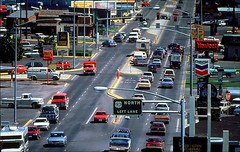
News
By Stefanie Seskin, November 11, 2009

Dangerous by Design, the new report from Transportation for America and the Surface Transportation Policy Project, illustrates just how serious pedestrian safety must be taken. The loss of life is equivalent to a jumbo jet going down roughly each month, yet receives little attention or funding and could be prevented by safer, complete streets.
Transportation for America, the National Complete Streets Coalition, and others are meeting with Transportation Secretary Ray LaHood on Monday afternoon. At this meeting, we will deliver signatures from thousands of Americans who believe complete streets must be a priority.
Sign the petition today and help us send a strong message to the US Department of Transportation!
Secretary LaHood has already shown a passion for safety and is a vocal proponent of livable communities. Complete Streets handily links both of the issues (as well as number of others). If Secretary LaHood makes it one of his priorities, transportation projects nationwide will provide safe travel for all users, regardless of age, ability, or mode of transportation. This is a great opportunity for organizations, communities, and individuals across the country to show how the tremendous magnitude of support for complete streets - please sign the petition today!

Our meeting is riding on a wave of media attention for
Dangerous by Design from news outlets nationwide. NPR's Morning Edition aired a piece on the hostility of suburban roadways, including interviews with Barbara McCann, Executive Director of the National Complete Streets Coalition, and a transit rider who regularly risks injury (or worse) dashing across six lanes of traffic to her bus stop. The Christian Science Monitor also picked up on the report's release, discussing it from several angles: safety, public health, and providing for our aging population.
On a more local level, change is already happening. Lee County, Florida has had a complete streets resolution on the table for a few months, but the last week’s Dangerous by Design report has helped push them into action. Last Monday, the News-Press ran an editorial in favor of the resolution. The reason, said the editorial board, is simple: “Florida is rated No. 1 per capita in pedestrian and cyclist fatalities.”
The following day, Jim Nathan, president of the Lee Memorial Health System, wrote a letter to News-Press saying “it is all too common for pedestrians and bicyclists to end up in the Trauma Center at Lee Memorial Hospital” and that “many of these accidents are preventable” with better, safer streets for everyone.
Later that afternoon, the Lee County commissioners unanimously approved a complete streets resolution citing not only the safety imperative, but also the need for active living and reduced emissions. Commissioner Brian Bigelow was moved by testimony from community members, including one who was hit by car with bicycling. “She is a victim of what’s really wrong with the way we’ve been kind of singularly focused on accommodating automobiles in our county. It’s been quite literally to the exclusion of other alternative modes of transportation.”

In Connecticut, a coalition of advocacy groups issued a press release stating that "minor changes to transportation policies and funding practices" can help prevent pedestrian fatalities, which represent 12.6% of total traffic fatalities statewide but receive less than 2% in safety funding. Connecticut recently passed a complete streets law, showing progress in becoming more friendly to people who do not travel by car alone. Though the law dedicates 1% of transportation funding to implementing the law, the DOT can do more. The coalition of advocates are specifically calling for 10% of federal Highway Safety Improvement Program (HSIP) money and 10% of federal Congestion Mitigation and Air Quality (CMAQ) funding for programs that prevent traffic injuries and fatalities.
Many communities want to replicate the great success of Columbia, Missouri, where there are relatively few deaths but many people walking. In 2004, Columbia adopted a complete streets ordinance, requiring pedestrian and bicyclist accommodation in road projects. Dangerous by Design ranks Columbia is the safest community for pedestrians in the state.
Related News

© 2025 Smart Growth America. All rights reserved
Site By3Lane Marketing










